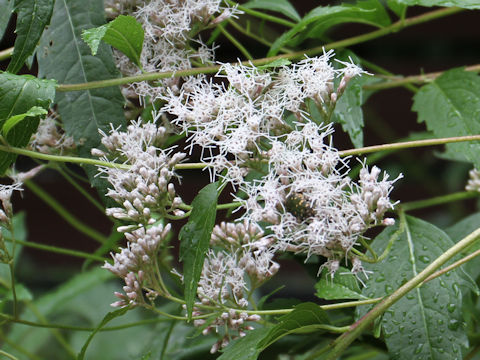
|
|
|
|
-- もっと見る(Show more)--
|
|
|
|
わが国の本州、関東地方以西から四国、九州それに台湾や朝鮮半島、中国に分布しています。秋の七草にも数えられていますが、奈良時代に薬草として中国から渡来したものです。川の堤防などに群がって生え、高さは1~1.5メートルになります。葉はふつう深く3裂しますが、下部の葉では分裂しないこともあります。また葉は対生し、短い柄があります。8月から10月ごろ、茎の先に散房花序をだし、淡い紅紫色から白色の花を咲かせます。古くは「蘭草」と呼ばれ、乾燥させると芳香があり衣料の薫蔵に使われたといいます。台湾華語では「塔山澤蘭」、中国語では「白頭婆(bai tou po)」と呼ばれます。 |
|
|
キク科ヒヨドリバナ属の多年草で、学名は Eupatorium japonicum。英名はありません。 |
|
|
The "Fuji-bakama" (Eupatorium japonicum) belongs to Asteraceae (the Aster family). It is a perennial herb that is distributed westward from Kanto district of Honshu to Shikoku and Kyushu, as well as Taiwan, the Korean Peninsula and China. This herb was introduced into Japan as a medicinal herb from China in Nara Era (710-794). This herb grows gregariously in dry riverbeds, and it can reach 1-1.5 m in height. The leaves are usually divided into trilobate, but occationally not divided at the lower parts of stems. They are arranged in opposite with short petioles. The pale magenta to white flowers bloom in corymbs atop of stems from August to October. In ancient times, it was called "ran-gusa" (orchid grass) and was used to scent clothes because of its fragrance when dried. In Taiwanese Chinese, it is called "塔山澤蘭" and in Chinese "白頭婆" (bai tou po). |
|
|
[上・中1] 茨城県つくば市「つくば実験植物園」にて、2012年10月27日撮影。 [中2・中3] 宮城県仙台市青葉区「東北大学植物園」にて、2016年05月14日撮影。 [中19~20・下] 同上にて、2024年11月21日撮影。 [中4~中10] 大阪府河内長野市「花の文化園」にて、2017年09月22日撮影。 [中11~中18] 福岡市中央区「福岡市植物園」にて、2017年10月06日撮影。 |

|
|
Shu Suehiro |





















